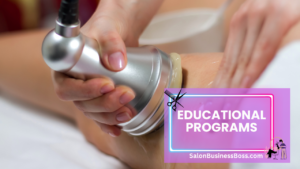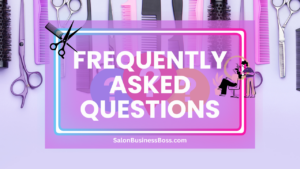Obtaining a hair license is a pivotal step for aspiring hairstylists, barbers, and cosmetologists. This credential demonstrates a professional’s competence and adherence to industry standards. However, the cost associated with acquiring a hair license can vary significantly depending on several factors.
Hair license cost approximately $45 to $140, covering educational programs, training materials, state exams, professional licensing fees, continuing education, and incidental expenses. A worthwhile investment for aspiring hairstylists, barbers, and cosmetologists, unlocking opportunities in the dynamic beauty industry.
1. Educational Programs:

The path to obtaining a hair license begins with enrolling in an accredited educational program. These programs serve as the foundational stepping stone for aspiring hair professionals, providing them with the necessary knowledge and practical skills required in the industry. Typically offered by cosmetology schools and vocational institutions, these educational programs play a crucial role in shaping the future hairstylists, barbers, and cosmetologists.
The cost of these educational programs can vary significantly, depending on various factors. One of the primary factors influencing the cost is the school’s reputation. Well-established institutions with a history of producing successful graduates may charge higher tuition fees due to their perceived quality of education. Conversely, newer or less renowned schools may offer more budget-friendly options to attract students.
Location is another crucial determinant of the cost. Cosmetology schools situated in metropolitan areas or regions with higher living costs generally have higher tuition fees to offset their operating expenses. In contrast, schools in rural areas or smaller towns may offer more affordable programs to accommodate students with limited budgets.
The program length is also a key consideration. A comprehensive cosmetology program that covers a wide range of hair-related topics and techniques will typically have a longer duration and, consequently, a higher cost. On the other hand, shorter programs focused on specific areas of hairstyling or barbering may have lower tuition fees.
On average, a comprehensive cosmetology program may cost between $5,000 to $20,000. This range includes tuition, fees, and sometimes the cost of training materials and textbooks. However, for individuals seeking more affordable options, community colleges can be an attractive choice. Some community colleges offer cosmetology courses at a fraction of the cost, with programs ranging from $1,000 to $5,000. These programs still meet the educational requirements for obtaining a hair license but may have a narrower scope compared to more extensive private institutions.
Ultimately, the cost of the educational program is an important consideration for aspiring hair professionals. Balancing budget constraints with the desire for a comprehensive education is crucial. Prospective students should thoroughly research different schools, compare program offerings and costs, and consider financial aid options to make an informed decision that aligns with their career goals and financial capabilities.
Read more about: Setting Up a Hair Salon: Practices and Strategies
2. Training Materials and Tools:
Beyond the theoretical knowledge gained in the educational program, practical experience is a vital aspect of obtaining a hair license. Aspiring hair professionals must invest in a range of training materials and tools to hone their skills and become proficient in the art of hairstyling. These essential tools are the building blocks of hands-on training, allowing students to practice various techniques and styles.
The primary tools required by aspiring hairstylists, barbers, and cosmetologists include hairdressing shears, clippers, blow dryers, curling irons, and mannequin heads. Hairdressing shears are a fundamental tool for cutting and shaping hair with precision, and they come in various types and sizes to accommodate different cutting styles.
Clippers, on the other hand, are indispensable for barbers, enabling them to perform clean and precise haircuts. The quality of clippers can significantly impact the cutting experience, making it essential for students to invest in reliable and efficient models.
Blow dryers are essential for styling and drying hair effectively. These tools come with various features, such as different heat settings and attachments, allowing hairstylists to achieve the desired look for their clients.
Curling irons are crucial for creating various types of curls and waves. Aspiring hairstylists need to select curling irons with different barrel sizes to offer a diverse range of styling options to their future clients.
Mannequin heads serve as practice models, allowing students to experiment with different hairstyles, colors, and techniques. These mannequin heads closely mimic human hair, providing a realistic and safe environment for students to practice without the pressure of working on real clients.
The cost of these training materials and tools can vary depending on the quality and brand selected. High-quality professional-grade tools may be more expensive, but they often offer better performance, durability, and precision, making them a worthwhile investment for those serious about their future in the hair industry. On average, aspiring hair professionals can expect to spend anywhere from $200 to $800 on these essential tools.
3. State Licensing Exam Fees:
After successfully completing the educational program in hairdressing, barbering, or cosmetology, aspiring hair professionals must take the crucial step of passing a state licensing exam to officially obtain their hair license. This exam serves as a standardized assessment to gauge the candidates’ theoretical understanding and practical abilities, ensuring they meet the necessary industry standards.
Each state has its own licensing board responsible for overseeing the hair license examination process. As a result, exam fees can vary from state to state. On average, candidates can expect to pay anywhere from $100 to $300 to take the exam. This fee is typically non-refundable and is set by the licensing board to cover the administrative costs associated with the examination process.
The state licensing exam generally consists of two main components: a written exam and a practical exam. The written exam assesses candidates’ theoretical knowledge of hairdressing techniques, sanitation practices, safety regulations, and other relevant topics. It ensures that candidates have a strong foundation in the theoretical aspects of their profession.
On the other hand, the practical exam evaluates candidates’ hands-on skills and their ability to perform various hairdressing tasks competently. Candidates may be required to demonstrate haircutting, styling, coloring, and other practical applications. This component of the exam ensures that candidates can apply their knowledge effectively in real-world scenarios.
The state licensing exam is designed to be comprehensive and rigorous to maintain high industry standards and safeguard public health and safety. By passing this exam, candidates demonstrate their readiness to provide professional hair services to clients and uphold the industry’s reputation.
To prepare for the licensing exam, candidates often undergo additional review and practice sessions. They may attend exam preparation courses or workshops to reinforce their knowledge and fine-tune their practical skills. Many educational programs also integrate exam preparation into their curriculum to equip students with the necessary tools for success.
4. Professional Licensing Fees:
After successfully passing the state licensing exam, aspiring hair professionals are required to obtain their professional license to legally practice hairdressing, barbering, or cosmetology. Alongside the exam fees, candidates must pay a separate professional licensing fee to the state or local governing body. This fee is an essential aspect of maintaining the hair professional’s legal status and is usually renewable on an annual basis.
The cost of the professional licensing fee can vary based on several factors, including the region or state where the license is obtained and the specific type of license acquired. Different jurisdictions may set varying fees to account for administrative expenses, support regulatory bodies, and ensure compliance with industry standards.
In general, the professional licensing fee for hair professionals ranges from $25 to $100 per year. However, the exact cost may differ from one location to another. More populous states or cities with a higher demand for hair services may have slightly higher fees to accommodate the increased administrative workload associated with a larger number of licensed professionals.
The type of license obtained also influences the licensing fee. A hairstylist, barber, or cosmetologist may have distinct fees associated with their respective licenses. Additionally, some states may offer specialized licenses for specific services within the hair industry, such as hair extensions or chemical treatments, each with its own unique licensing fee.
It is essential for hair professionals to ensure they pay their professional licensing fee promptly to maintain an active license status. Operating without a valid license is illegal in most jurisdictions and may result in fines, penalties, or even the suspension of the individual’s right to practice.
Renewing the professional license annually is crucial to staying updated with any changes in regulations or industry standards. It also demonstrates the hair professional’s commitment to upholding the highest level of professionalism and adhering to the rules and regulations governing their practice.
5. Continuing Education:

In the ever-evolving world of hairdressing, barbery, and cosmetology, staying up-to-date with industry trends, techniques, and safety regulations is crucial for maintaining a hair license and providing top-notch services to clients. As such, continuing education is a vital aspect of a hair professional’s career journey.
Many states recognize the significance of ongoing education and require hair professionals to complete a certain number of continuing education hours during each license renewal period. These mandatory education hours aim to ensure that licensed professionals remain knowledgeable about the latest advancements in the field and are well-versed in modern practices and safety protocols.
The number of continuing education hours required can vary from state to state. Some states may mandate a specific number of hours, while others may set requirements based on the type of license held. Typically, hair professionals should expect to dedicate anywhere from a few hours to several days of education and training per license renewal cycle.
The cost of continuing education courses can vary based on several factors, including the institution or organization providing the training, the duration of the course, and the topics covered. On average, professionals should budget around $100 to $300 for each renewal cycle, though some specialized courses may be more expensive.
Continuing education courses cover a wide range of topics, from advanced hairstyling techniques and hair coloring trends to sanitation practices, customer service, and business management. These courses are designed to equip hair professionals with the latest knowledge and skills needed to excel in their careers and meet the changing demands of clients.
Apart from the regulatory requirements, many hair professionals also pursue continuing education voluntarily to enhance their expertise and expand their service offerings. By continuously updating their skillset, they can better cater to clients’ diverse needs and preferences, which in turn leads to increased client satisfaction and loyalty.
Attending workshops, seminars, and webinars also presents opportunities for networking with industry peers and professionals. Sharing experiences and knowledge can foster a sense of community and collaboration among hair professionals, fostering a spirit of continuous improvement and growth within the industry.
Read more about: What Education Is Needed to Become A Salon Owner
6. Miscellaneous Expenses:
The journey to obtaining a hair license involves more than just completing educational programs and passing licensing exams. Aspiring hair professionals must be prepared for various additional expenses that can arise throughout the licensing process. While these miscellaneous costs may seem minor individually, they can collectively add up, contributing to the overall financial commitment required to become a licensed hairdresser, barber, or cosmetologist.
Textbooks are essential learning resources during the educational program. While some schools may provide textbooks as part of the tuition, others may require students to purchase them separately. The cost of textbooks can vary depending on the number of subjects covered and their specific titles, ranging from $50 to a few hundred dollars.
Uniforms are a common requirement in cosmetology schools and serve as a professional dress code during hands-on training. Students may need to invest in specific attire, such as lab coats or smocks, which can cost anywhere from $30 to $100, depending on the quality and brand.
Application fees are often associated with the initial license application process. These fees cover administrative costs for processing the application and are typically non-refundable. The amount varies by state and can range from $25 to $100 or more.
Travel expenses can be incurred when attending licensing exams or job interviews. Candidates may need to travel to specific exam locations or potential job opportunities, leading to additional costs for transportation, accommodation, and meals.
Some candidates may choose to attend industry-related events, workshops, or conventions to network and enhance their skills. While attending these events can be beneficial for career growth, it may entail costs for event registration, travel, and accommodation.
To manage these miscellaneous expenses effectively, aspiring hair professionals should budget carefully and plan ahead. Researching different educational programs and comparing their associated costs, including additional fees and required materials, can help candidates make informed decisions.
Exploring financial aid options, such as scholarships or grants, can alleviate some of the financial burden associated with obtaining a hair license. Many cosmetology schools offer financial assistance programs to support deserving students in pursuing their dreams.
Conclusion
Obtaining a hair license is a critical step for individuals aspiring to build a successful career in the hair industry. The cost of acquiring this credential can range from approximately $45 to $140, encompassing expenses related to educational programs, training materials, state licensing exams, professional licensing fees, continuing education, and various miscellaneous costs. While the initial investment may seem daunting, the value of a hair license opens doors to numerous opportunities, making it a worthy pursuit for those passionate about the art of hairdressing, barbering, or cosmetology. Aspiring hair professionals should carefully research and plan their financial commitments to embark on a fulfilling and rewarding journey in the world of hair styling and beauty.
Frequently Asked Questions

1. Can I deduct hair license costs as business expenses?
Depending on your country’s tax laws, you may be able to deduct hair license costs as business expenses. Consult a tax professional for accurate guidance.
2. Is financial aid available for cosmetology educational programs?
Yes, many cosmetology schools offer financial aid options, including scholarships, grants, and student loans.
3. Are there any specific prerequisites for enrolling in a cosmetology program?
Prerequisites for cosmetology programs may vary, but a high school diploma or equivalent is typically required.
To learn more on how to start you own salon checkout my startup documents here.
Please note that the contents of this blog are for informational and entertainment purposes only and should not be construed as legal advice. Any action taken based on the information provided in this blog is solely at your own risk. Additionally, all images used in this blog are generated under the CC0 license of Creative Commons, which means they are free to use for any purpose without attribution.

About the author. Entrepreneur and Salon Business Fan.
Hi! I am Shawn and I am a happy individual who happens to be an entrepreneur. I have owned several types of businesses in my life from a coffee shop to an import and export business to an online review business plus a few more and now I create online salon business resources for those interested in starting new ventures. It’s demanding work but I love it. I do it for those passionate about their business and their goals. That’s why when I meet a salon business owner, I see myself. I know how hard the struggle is to retain clients, find good employees and keep the business growing all while trying to stay competitive.
That’s why I created Salon Business Boss: I want to help salon business owners like you build a thriving business that brings you endless joy and supports your ideal lifestyle.

